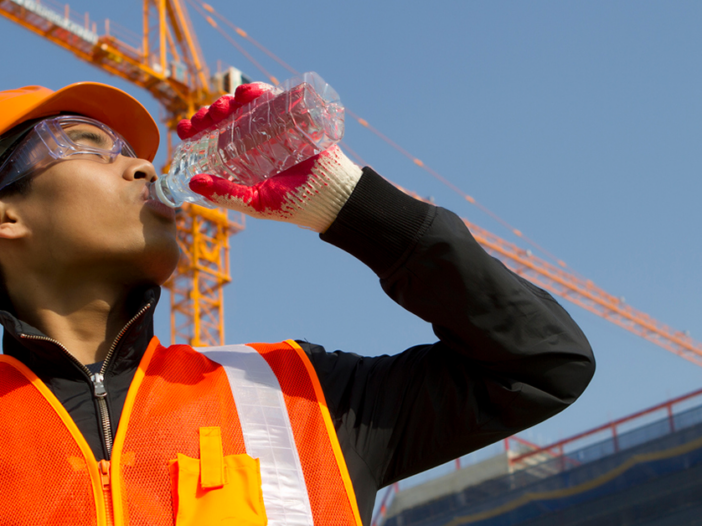
Which of these summer safety hazards do your outdoor workers face?
Excessive heat. Wildfires. Tornadoes. Hurricanes. Have you prepared your workers for these summer safety hazards? Add to those hazards the fact that days are longer, with more workable hours. Workers are headed back to the worksite or are starting new jobs. What steps can you take to protect your workforce, particularly your new workers who’ve never summered with you before?
Heat illness
“When each new summer becomes ‘the hottest summer on record,’ protecting employees from heat stress continues to be a challenge,” says EHS Daily. If your company is in agriculture, construction, landscaping or any other outdoor industry, your top summer safety hazard may be heat stress. It’s crucial for you to monitor heat advisories from the National Weather Service.
Workers at risk of heat illness also include anyone in hot environments such as firefighters, bakery workers, boiler room workers, factory workers and others. Employees who are overweight or 65 years of age or older, have heart, disease or high blood pressure, or take certain medications are at greater risk of workplace heat stress.
New workers or those unaccustomed to working in high temperatures need to acclimatize to the heat, taking time to build up a tolerance for hot conditions. Newer outdoor workers need to consume adequate amounts of liquid, start off with shorter shifts and learn how to recognize heat illness symptoms.
Learn more about the types of heat illness and their symptoms, plus how to enact a workplace heat illness prevention program, in an earlier blog post.
Wildfires
Currently, more than nearly 500,000 acres have burned across the U.S. this year. Drought conditions exist in 20 states, ranging from moderate to exceptional drought, creating the perfect storm for wildfires. While wildfires can occur all year long, they ignite most often in summer and fall months, making them one of the summer safety hazards in western, southwestern or midwestern states. Employers need to have in place a wildfire preparedness plan, including plans for evacuation, assigned roles and a chain of command, plus specified exits and evacuation routes. Wildfire smoke can carry hundreds of miles away, creating a respiratory hazard, even if you’re not near a fire danger. Your outdoor workers may need to work shorter shifts or be moved to an area with better air quality.
If you have a facility in a fire-prone region, you need to ensure that your HVAC system is working properly, and air filters are clean. We recommend checking with your HVAC technician about the highest filtration rating your HVAC system will support and use the highest rating possible when smoke is present.
Hurricanes
The National Oceanic and Atmospheric Administration (NOAA) forecasts yet another above-normal Atlantic hurricane season this year, with a predicted 17 to 25 named storms and 8 to 13 hurricanes, including 4 to 7 major hurricanes. Thus, hurricanes are inarguably a top summer safety hazard for workers.
For organizations along the Eastern Seaboard or Gulf Coast, having a robust emergency plan is crucial. The plan should include evacuation procedures; emergency function assignments, such as having designed employees ready to shut down machinery and utilities; and a method for accounting for employees, customers and visitors.
Post-hurricane, employees face a new onslaught of hazards like electrocution, cuts, falls, infections from high water and hidden wildlife. Employers should keep these additional risks in mind when crafting an emergency plan.
Related: Safety tips for business recovery after a hurricane or other disaster
Tornadoes
Tornadoes sometimes can be more dangerous than hurricanes, primarily because they often occur with little-to-no warning. Of the 1,200+ tornadoes that touch down in the U.S. annually, truly violent ones account for only two percent of the total. However, they cause 70 percent of all tornado deaths. That means you should treat every warning of an impending tornado with the same life-or-death urgency.
Statistics show that each year, an average of 227 people are killed by tornadoes, which wreak $1.086 billion in damage annually. They can generate wind speeds of up to 200 mph, creating damage up to one mile wide and 50 miles long.
Related: Prepare for tornadoes and windstorms
Worksite fatigue
New workers (and older ones as well) need to be made aware of additional stresses and strains on their bodies. Standing for long periods not only cause sore feet and backaches, but also cause swelling of the limbs, bunions, extra pressure on the joints and general fatigue. These ailments can affect employee performance, mental capacity, eventually leading to heart disease or other declining health conditions over time.
Related: Help workers prevent worksite fatigue
Resources: Are You Ready to Get Ahead of Summer Safety Hazards?
This post originally appeared on Arrowhead’s corporate blog. It has been modified and updated to better reflect the needs of our tribal clients and their agents.
